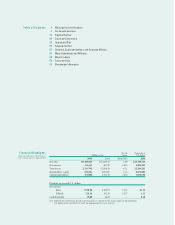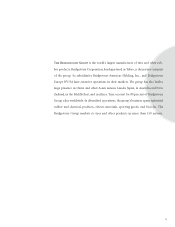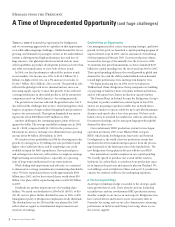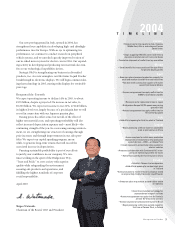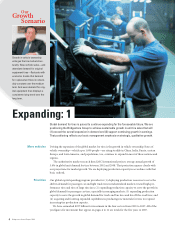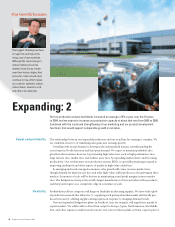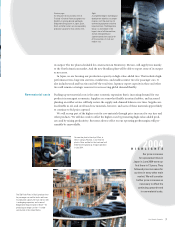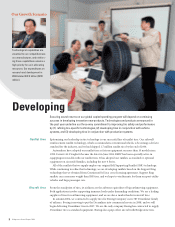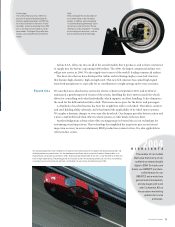Bridgestone 2004 Annual Report Download - page 6
Download and view the complete annual report
Please find page 6 of the 2004 Bridgestone annual report below. You can navigate through the pages in the report by either clicking on the pages listed below, or by using the keyword search tool below to find specific information within the annual report.
4
Bridgestone Annual Report 2004
Growth in vehicle ownership
enlarges the tire market struc-
turally. New-vehicle sales—and
attendant demand for original
equipment tires—fluctuate with
economic trends. But demand
for replacement tires is remark-
ably constant over the medium
term. And even demand for orig-
inal equipment tires displays a
consistent rising trend over the
long term.
Expanding: 1
Our
Growth
Scenario
Driving the expansion of the global market for tires is the growth in vehicle ownership. Rates of
vehicle ownership—vehicles per 1,000 people—are rising steadily in China, India, Russia, eastern
Europe, and Latin America, and populations, too, continue to expand in most of those nations and
regions.
The authoritative market research firm LMC International projects average annual growth of
3.6% in global unit demand for tires between 2002 and 2008. That projection squares closely with
our projections for market growth. We are deploying production capacity in accordance with that
basic outlook.
Our global capital spending program provides for (1) deploying production resources to serve the
shift in demand for passenger car and light truck tires in industrialized markets toward high-per-
formance tires and tires of large rim sizes; (2) expanding production capacity to serve the growth in
global demand for passenger car tires, especially in emerging markets; (3) expanding production
capacity to serve the growth in global demand for truck and bus tires and for off-the-road tires; and
(4) acquiring and fostering expanded capabilities in producing raw materials for tires to respond
increasing tire production capacity.
We have earmarked ¥227 billion for investment in the four sectors from 2003 to 2007. All of the
yen figures for investment that appear on pages 4 to 11 are totals for the five years to 2007.
Global demand for tires is poised to continue expanding for the foreseeable future. We are
positioning the Bridgestone Group to achieve sustainable growth in unit tire sales that will
(1) exceed the overall expansion in demand and (2) support continuing growth in earnings.
That positioning reflects our basic management emphasis on strategic, qualitative growth.
Priorities
More vehicles


